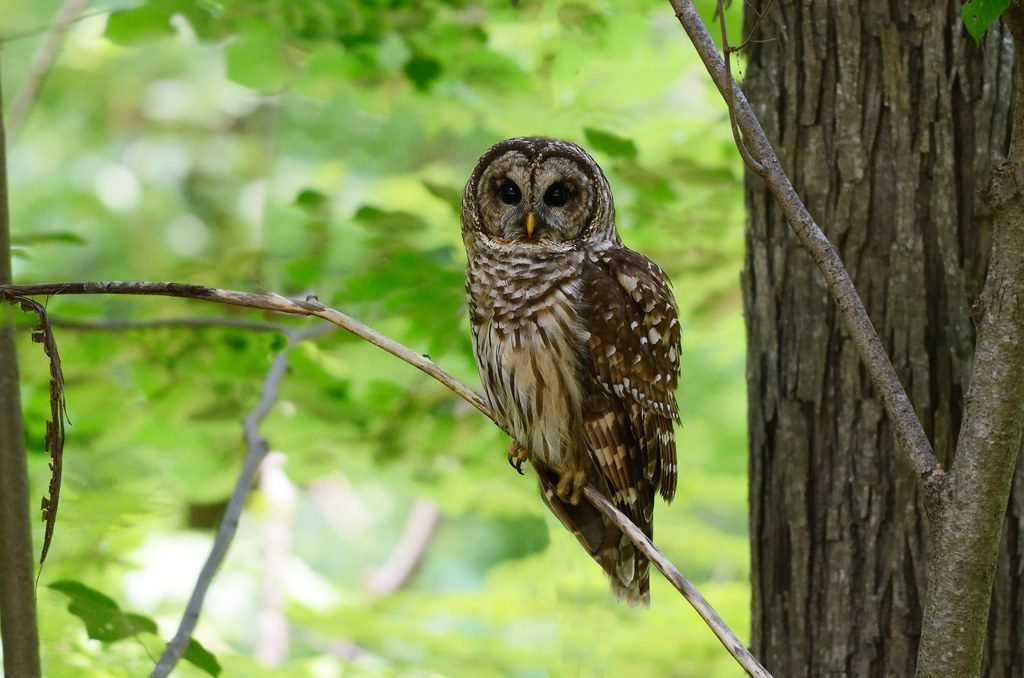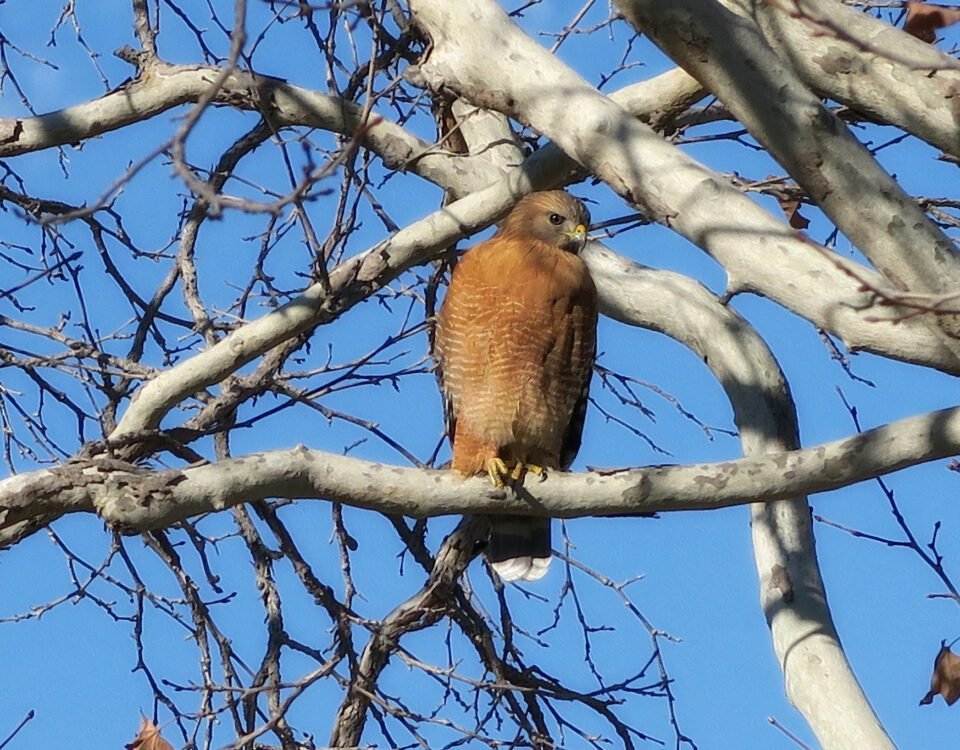


Can Birds Eat Tomatoes? [Safe Vs. Unsafe Types]
October 21, 2023


Do Hawks Attack & Eat Foxes? Your Question Answered
October 21, 2023Owls are indeed majestic and powerful rulers of the night skies. Their exceptional night vision, acute hearing, remarkable hunting skills, and agile flight abilities equip them perfectly to prey on smaller birds and animals. But can they target larger prey, such as foxes? Do owls have foxes on their menu? Let’s find out!
Although the majority of owls typically pursue smaller prey like mice and voles, there are certain species with the capacity to take on much larger animals. For example, the Great Horned Owl and the Eagle Owl have been reported to prey on foxes when food sources are limited. However, these incidents are extremely rare.
Let’s explore more details of this topic.
Related Read: Do Hawks Attack & Eat Foxes? Your Question Answered
Do Owls Eat Foxes? Why Do They Do That?
Owls, being raptors, are naturally inclined to hunt and consume other creatures. Among their varied diet, foxes are potential targets, though pets like cats and dogs can also be at risk.
Typically, owls favor smaller prey such as rodents, birds, rabbits, and squirrels. They have also been known to feast on fish, amphibians, reptiles, and invertebrates. While the thought might be alarming, human encounters with predatory owls are rare.
An adult fox is generally too big to be a regular staple in an owl’s diet, but if the opportunity presents itself, an owl won’t shy away.


Barred Owls
Owls can efficiently dismantle their prey with their powerful talons and razor-sharp beaks. If an owl manages to secure a fox, it will use its talons to tear into it before consuming it.
That said, lifting a full-grown fox is unconquerable for even the most giant owls, making juvenile foxes more likely targets.
While many animals understandably fear the owl’s presence, foxes can be aggressive competitors, occasionally retaliating and overpowering an attacking owl.
Related Read: Are Birds Carnivores? A Look at Different Bird Species
How Do Owls Hunt Foxes?
An owl’s sharp talons and formidable claws can be deadly for a fox. A precise strike from an owl can pierce the fox’s skull, leading to an immediate demise. This hunting technique is highly effective, though it has its dangers.
If the owl does not land a direct hit, it exposes itself to potential harm from the fox’s biting teeth and slashing claws. Hence, owls usually go after foxes only when they’re confident of delivering a lethal blow without error.
Which Owl Actively Preys On Foxes?
While many owl species, like the barn owl, typically avoid hunting foxes and instead favor smaller prey such as rodents, insects, and fish, there are exceptions among the larger ones.
The Eurasian eagle-owl, one of the world’s most powerful owls, has been documented attacking foxes that weigh up to 15 pounds. In the same vein, the great horned owl can prey on both juvenile foxes and adults.


Great Horned Owls
Though most owls tend to avoid interactions with such formidable animals, hunger can drive them to take on a fox if the circumstances align.
Can Foxes And Owls Share A Same Habitat?
Absolutely. It’s not uncommon to find foxes and owls living within the same regions. However, their cohabitation doesn’t necessarily translate to significant interactions or influence over one another’s population due to their distinct diets and ways of life.
Both foxes and owls are globally distributed, with numerous species, each with unique habitat preferences.
Take the Red Fox as an example, which is the most prevalent fox species. This adaptable creature thrives in various environments, including forests, grasslands, deserts, and even cityscapes.


Red Fox
On the other hand, the Great Horned Owl, prevalent in North America, isn’t finicky about its habitat either. It’s comfortable in various settings, from thick woodlands to suburban areas.
This versatility in habitat selection for both species means their paths often cross in the same territories.
Nevertheless, they don’t compete directly or view each other as threats. Instances have been recorded where foxes and owls come across each other and simply carry on, indicating mutual acceptance when cohabitating in similar spaces.
How Do Foxes Defend Against Owl Attack?
Foxes have several defensive tactics they can employ if threatened by a large owl:
- Evasion: The primary method a fox will use when faced with a threat is to escape. They are agile creatures and can quickly dart into underbrush or bolt for their dens.
- Camouflage: Foxes’ fur can often blend well with their surroundings, particularly during certain seasons. A fox can avoid detection by staying still and low to the ground.
- Vocalizations: Foxes can emit a range of vocalizations, some of which can serve as alarms or deterrents to potential predators. The unexpected and loud noise might startle an approaching owl.
- Defensive Posture: If cornered, a fox might adopt a defensive posture – standing its ground, baring its teeth, and arching its back.
- Retaliation: Foxes have sharp teeth and strong jaws. They also possess sharp claws. If an owl gets too close, a fox might try to bite or scratch in self-defense.
- Protecting Offspring: Adult foxes are particularly protective of their young. If an owl approaches a den or tries to prey on fox kits, the adult foxes will become aggressive in defending their offspring.
Would A Fox Prey On An Owl?
Foxes are fascinating creatures with a knack for being opportunistic feeders, capitalizing on any available food source. As a result, they readily prey on smaller animals such as rodents and birds.


Would A Fox Prey On An Owl?
In North America, foxes stand out as primary predators of owls. The underlying reason is straightforward: foxes possess the cunning and agility to outsmart and outpace their avian targets. While owls might be professional in the air, foxes excel at stealthily tracking them from the ground, eventually ambushing and delivering a lethal bite to the owl’s neck.
Final Thoughts
The dynamic between foxes and owls highlights the complex tapestry of our ecosystem. While both creatures steer the landscape with remarkable skill and adaptability, their interactions provide a fascinating glance into the world of predator and prey.
With their opportunistic nature, Foxes have showcased their prowess in exploiting various food sources, sometimes even outwitting the challenging owls.
Conversely, owls, rulers of the nocturnal skies, possess their own set of predatory tools. However, more than competitors, they are two species trying to thrive in a shared habitat. Their delicate balance is a testament to nature’s intricate design and the continuous ebb and flow of life in the wild!



